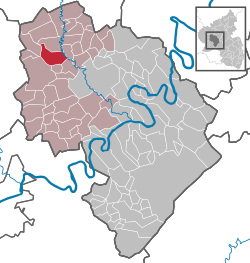Großlittgen
| Großlittgen | ||
|---|---|---|
|
||
| Coordinates: 50°01′34.73″N 06°47′56.28″E / 50.0263139°N 6.7989667°ECoordinates: 50°01′34.73″N 06°47′56.28″E / 50.0263139°N 6.7989667°E | ||
| Country | Germany | |
| State | Rhineland-Palatinate | |
| District | Bernkastel-Wittlich | |
| Municipal assoc. | Wittlich-Land | |
| Government | ||
| • Mayor | Karl - Heinz Hubo | |
| Area | ||
| • Total | 13.20 km2 (5.10 sq mi) | |
| Elevation | 310 m (1,020 ft) | |
| Population (2015-12-31) | ||
| • Total | 965 | |
| • Density | 73/km2 (190/sq mi) | |
| Time zone | CET/CEST (UTC+1/+2) | |
| Postal codes | 54534 | |
| Dialling codes | 06575 | |
| Vehicle registration | WIL | |
| Website | www.grosslittgen.de | |
Großlittgen (in Eifel dialect: Gruhssleehtchen) is an Ortsgemeinde – a municipality belonging to a Verbandsgemeinde, a kind of collective municipality – in the Bernkastel-Wittlich district in Rhineland-Palatinate, Germany.
The municipality lies in the Eifel and belongs to the Verbandsgemeinde Wittlich-Land.
In 912, Großlittgen had its first documentary mention as Lutiaco. In 1134 or 1135, Bernhard von Clairvaux founded the Cistercian Himmerod Abbey near the village. During the French Revolutionary Wars, Großlittgen ended up under French rule beginning in 1794. In 1802, Himmerod Abbey was dissolved. In 1814 it was assigned to the Kingdom of Prussia at the Congress of Vienna. In 1922, the Abbey was founded anew by German Cistercian monks from the Marienstatt Monastery in the Westerwald. Since 1947, it has been part of the then newly founded state of Rhineland-Palatinate.
The council is made up of 16 council members, who were elected by proportional representation at the municipal election held on 7 June 2009, and the honorary mayor as chairman.
The municipal election held on 7 June 2009 yielded the following results:
The German blazon reads: Unter silbernem Schildhaupt, darin ein rotes Balkenkreuz, durch eingeschweifte goldene Spitze, darin ein schwarzer Löwe, gespalten: rechts in Rot ein silbernes Schwert, links in Rot zwei ineinander geschlungene goldene Ringe.
The municipality’s arms might in English heraldic language be described thus: Tierced in mantle, dexter gules a sword bendwise sinister argent, sinister gules two annulets embraced in pale Or, in base Or a lion rampant sable, in a chief of the second a cross of the first.
...
Wikipedia



